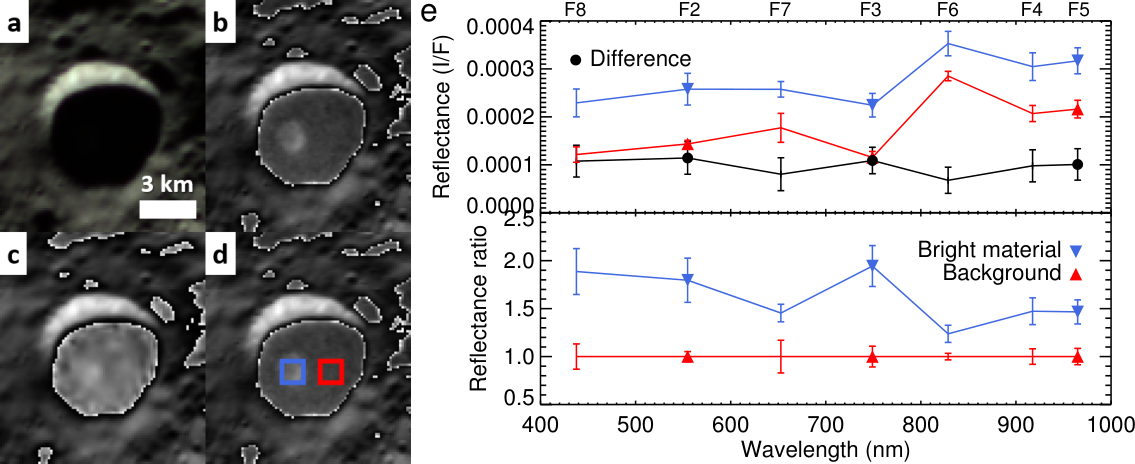Spectral properties of bright deposits in permanently shadowed craters on Ceres
- 1Luleå University of Technology, Sweden (stefanus.schroder@ltu.se)
- 2Planetary Science Institute, Tucson, USA
- 3NASA Goddard Space Flight Center, Greenbelt, USA
- 4German Aerospace Center, Berlin, Germany
Permanently shadowed regions (PSR) on the Moon and Mercury are thought to harbor volatiles such as water ice (Arnold 1979; Slade et al. 1992; Feldman et al. 2001; Lawrence 2017). PSRs have also been identified in the polar regions of dwarf planet Ceres (Schorghofer et al. 2016). A handful of Ceres PSRs contain bright deposits (Platz et al. 2016). Ceres' obliquity varies between 2.0° and 19.5° with a period of roughly 20 kyr, and the extent of individual PSRs changes accordingly (Ermakov et al. 2017). Only the most persistent PSRs contain bright deposits, which suggests that bright deposits in PSRs harbor volatiles accumulated in cold traps, most likely water ice (Schorghofer et al. 2024). Nevertheless, bright deposits on Ceres typically have a salty composition (e.g., de Sanctis et al. 2016).
We determine the spectral properties of bright deposits on the shadowed floor of craters in map-projected, narrow-band images of the Dawn framing camera (FC) to find direct evidence for water ice. The spectrum of water ice generally has a negative (blue) slope in the visible range, with steeper slopes for larger particle sizes (e.g., Clark 1981, Raponi et al. 2016). Thus, we are looking for the tell-tale sign of a negative spectral slope. Analyzing the low reflectance values in shadowed craters requires special care because FC narrow-band images were degraded by substantial in-field stray light (Sierks et al. 2011, Schröder et al. 2014). In addition, the images used in our analysis were compressed with a lossy algorithm prior to transmission, which may lead to visible artifacts depending on the compression ratio and the image content. We corrected the images in our analysis for stray light and carefully assessed the image quality with respect to compression artifacts.
The bright deposit in the permanently shadowed Bilwis crater is shown in Fig. 1. The reflectance of this deposit is so low that artifacts associated with high compression ratios are expected to be significant. Also, residual stray light may contribute significantly to the reflectance, in which case the difference between the spectra of the deposit and background terrain may be more representative for the bright material than the ratio of these spectra. The difference spectrum of bright deposit and background terrain has a neutral spectral slope for the reliable bands (low compression ratio). If we include the less reliable bands (high compression ratio) into consideration, the spectral slope is still neutral. The ratio spectrum for the reliable bands seems to have a spectral slope that is not significantly different from neutral. If we include the less reliable bands into consideration, the spectral slope appears to be negative, although the scatter in the data is considerable. In short, the spectral slope of the bright deposit appears to be neutral, with weak evidence for a negative (blue) slope.

Fig. 1. Bright deposit in Bilwis crater. (a) Color composite with (R, G, B) = (F5, F2, F8). (b) F2 image (low compression ratio) with the contrast enhanced in shadowed areas, revealing the bright deposit. (c) F6 image (high compression ratio) with the contrast enhanced in shadowed areas, uncovering compression artifacts. (d) F2 image in (b) with the sampled areas outlined. Outline colors correspond to the curves in (e). (e) Spectra associated with the areas indicated in (d). Data points with a symbol derive from images with a low compression ratio and are therefore more reliable. Top: Bright material and background spectra and their difference. Bottom: Bright material and background spectra divided by the background spectrum.
We performed this analysis for several bright deposits in PSRs. While some clearly show the spectral signature for water ice (negative spectral slope), for others the evidence is only marginal. However, the fact that all deposits have negative spectral trends leads us to conclude that, in general, bright deposits in PSRs exhibit a negative spectral slope. On Ceres, material with a negative spectral slope is commonly found in young terrain, but it is not bright (Schmedemann et al. 2016, Schröder et al. 2017). On the other hand, typical bright terrains on Ceres are salt deposits, which feature a spectral slope ranging from neutral to positive (de Sanctis et al. 2016, Schröder et al. 2017). Therefore, the bright deposits in the PSRs are unlikely to be salts and our work constitutes a direct detection of water ice in the bright deposits in Ceres PSRs.
References:
Arnold, J. R. 1979, J. Geophys. Res., 84, 5659
Clark, R. N. 1981, J. Geophys. Res., 86, 3087
Ermakov, A. I., Mazarico, E., Schröder, S. E., et al. 2017, Geophys. Res. Lett., 44, 2652
Feldman, W. C., Maurice, S., Lawrence, D. J., et al. 2001, J. Geophys. Res., 106, 23231
Lawrence, D. J. 2017, Journal of Geophysical Research (Planets), 122, 21
Platz, T., Nathues, A., Schorghofer, N., et al. 2016, Nature Astronomy, 1, 0007
Raponi, A., Ciarniello, M., Capaccioni, F., et al. 2016, MNRAS, 462, S476
de Sanctis, M. C., Raponi, A., Ammannito, E., et al. 2016, Nature, 536, 54
Schmedemann, N., Kneissl, T., Neesemann, A., et al. 2016, Geophys. Res. Lett., 43, 11,987
Schorghofer, N., Mazarico, E., Platz, T., et al. 2016, Geophys. Res. Lett., 43, 6783
Schorghofer, N., Gaskell, R., Mazarico, E., & Weirich, J. 2024, Planet. Sci. J., 5, 99
Schröder, S. E., Mottola, S., Matz, K. D., & Roatsch, T. 2014, Icarus, 234, 99
Schröder, S. E., Mottola, S., Carsenty, U., et al. 2017, Icarus, 288, 201
Sierks, H., Keller, H. U., Jaumann, R., et al. 2011, Space Sci. Rev., 163, 263
Slade, M. A., Butler, B. J., & Muhleman, D. O. 1992, Science, 258, 635
How to cite: Schröder, S., Schörghofer, N., Mazarico, E., and Carsenty, U.: Spectral properties of bright deposits in permanently shadowed craters on Ceres, Europlanet Science Congress 2024, Berlin, Germany, 8–13 Sep 2024, EPSC2024-379, https://doi.org/10.5194/epsc2024-379, 2024.